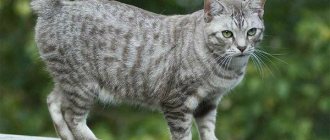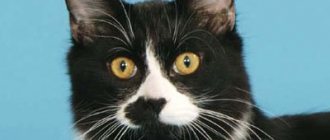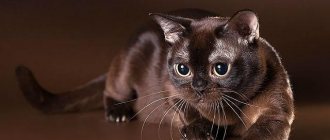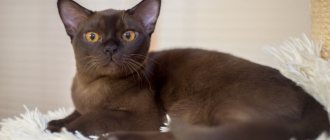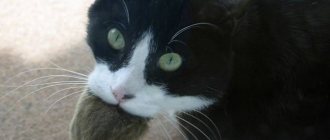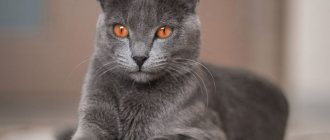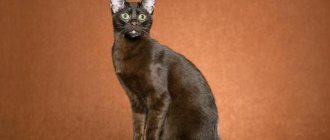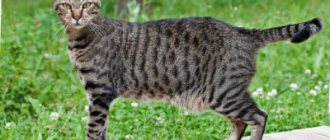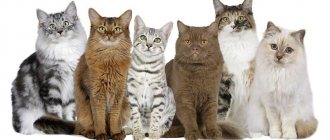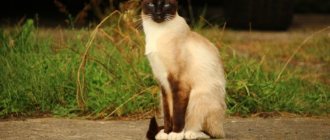Some popular cats, including rare varieties, are native to England. Despite the same origin, they have great differences in appearance and temperament. Moreover, some breeds are truly English, while others lived in Britain for a long time, but have ancestors from other parts of the world. Currently, English cats can be found all over the world.
Below is a list of breeds native to England.
When planning to purchase an animal of an unfamiliar breed, discuss its characteristics with a specialist. This will help you understand whether this cat is right for you or not.
Sphinx
The unusual appearance of this cat breed causes tenderness and delight in some, while in others it causes disgust and fear. Sphynxes are called “aliens” due to the folds on their face and skin, large ears and expressive green eyes. Sphynxes weigh up to 7 kg, have a wedge-shaped head with high and open ears, a muscular neck, narrow paws with wide toes and a thin tail.
Sphinxes are active, quickly make contact with people, and easily tolerate noise and mass fun. They do not show aggression and are restrained in their emotions when playing. The average price of an alien kitten is 6 thousand rubles.
Scottish Straight
As you know, Scots can be either lop-eared or straight-eared. Now we will talk about the latter. Straight-eared Scottish cats are very similar to the British. However, they have two differences: firstly, they are smaller in size, and secondly, they are lighter in weight. Due to this, they are much more graceful and active. Their muzzle is round and slightly flattened.
They are also practically no different from the Scottish Fold, but the English Scottish Straight cat breed is very important. The fact is that when breeding Scottish Folds, you can’t do without it. If you bring two Scots together, their kittens may develop malformations of the skeletal system, in particular cartilage. That is why one of the parents should be a Scottish Straight to ensure a healthy life for future offspring.
Asian tabby
This English cat breed was bred relatively recently - in 1982. Already in the 90s, her popularity increased sharply. And this is not surprising, since the animal looks simply magnificent. The breed was developed by crossing a Persian chinchilla and a Burmese cat. The Asian tabby inherited its color from the first, and its body structure from the second.
A distinctive feature of the breed is the dark edging around the nose, eyes and mouth. There are four types of colors: merle, spotted, brindle and markel. In addition, these cats should have some kind of necklace around their neck, which consists of dark thin stripes. The animal has straight ears and clearly visible cheekbones. In the photo of the English Asian tabby cat breed, it is clearly visible that its forehead is decorated with the so-called scarab sign, which has an unusual color.
It is worth noting that these pets are very friendly, adore children and get along well with their own kind, as well as with other types of animals. This is partly due to the fact that they have truly iron patience. Taking care of tabbies is not difficult, as they are unpretentious. Representatives of this breed usually live from 15 to 20 years.
Scottish fold
These cute creatures belong to the Scottish or British fold cat breed. However, breeders claim that the second name is incorrect. They are convinced that the British can only be straightforward. By the way, these cats are the most popular breed, while Scottish Folds take second place in popularity.
They owe their cute facial expression to the unusual shape of their downturned ears. Because of this feature, even in adulthood they look like little kittens. Such a touching appearance of representatives of the fold-eared English cat breed is perfectly complemented by a balanced character, devoid of even the slightest manifestation of aggression. Cats love peace, they are obedient and easy to train. They often stand on their hind legs for a long time.
The first cat with drooping ears was born in 1961 in Scotland. As it turned out, this feature was due to a gene mutation, which became a characteristic feature of the whole breed. The English cat, the photo of which is presented in this article, can have five types of color: tortoiseshell, patterned, lightened, chinchilla and solid. The most common color for Scottish Folds is blue.
British Shorthair
This breed appeared more than a century ago. Over all these years, her popularity has only grown. There is no reliable information about its origin, but there are many legends associated with it. Looking at photos of British breed cats, you can’t help but fall in love with them at first sight.
The color of animals can be different, but the most popular is plain blue. In addition to it, there is also black, purple and chocolate. There are other colors, such as tabby, in different combinations. Their eyes are most often bright orange or yellow, blue and green are a little less common. A distinctive feature of these animals is their wide head with a flattened muzzle.
The personality of British breed cats can change over time. Until one year of age, they lead a very active lifestyle, and then abruptly switch to the so-called sofa mode. This means that cats become very lazy and can sleep for several hours at a time. That is why the breed is most suitable for those families where there are no children, since it values peace very much. We can say that the British love to be alone, but they will not refuse the affection of their owner either.
British blue cat
The classic solid color made the breed extremely popular. Moreover, its fur can have different shades - from light blue to deeper. Thick cheeks and large yellow eyes give a specific expression to her muzzle. The tip of her nose and paw pads are colored to match her fur. This breed of English Shorthair cat has one feature that sets it apart from all the others. We are talking about wool. It is unusually thick, but at the same time short and very soft. Requires special care, which will require a special set of grooming equipment.
This breed is one of the oldest, as it was bred more than a hundred years ago. When creating it, the British used both purebred animals and ordinary street strays. The English Blue cat breed is distinguished by its calm, affectionate character and devotion to its owner. She is characterized by intelligence, pride and stubbornness at the same time.
Cornish Rex
The breed appeared in the middle of the last century thanks to a random gene mutation. The coat of these animals is incredibly dense and thick, and also has unusual curliness. Because of this, cats need to be bathed frequently to avoid possible problems with both hair and skin. Despite their thick coat, they can freeze, so hypothermia should be avoided. For the Cornish Rex, it is necessary to organize the warmest possible corner in the house where he can warm up at any time. When it's cold outside, walking with such a cat becomes impossible.
Cornish Rex are active, energetic and love various games. They cannot stand loneliness and strive to be close to their owner all the time. Therefore, such pets are not suitable for people who value peace. This cat breed is distinguished by great intelligence and the ability to learn quickly. Due to increased activity, their body requires more energy, and therefore more food. Unlike a regular cat, their diet should be approximately doubled.
Burmilla shorthair
Just like the previous English cat breed, it was formed by crossing a Burmese with a Persian chinchilla, however, unlike the Asian tabby, this happened by accident. The unusualness of this animal lies in the silver or golden hue of its fur. It should be preserved in any color and color. There can be a lot of the latter: chocolate, purple, cream and others. There are only four colors: brindle, smoky, solid and shaded.
The Burmilla's eye color can only be yellow or emerald. Representatives of this breed of both sexes have well-developed muscles. They are energetic and playful, but become calmer over the years. Burmillas are quite curious, so they spend most of their time looking for something interesting. They have good health, but are predisposed to polycystic kidney disease.
Himalayan cat
She was withdrawn in 1940. This English cat breed is the result of mating a Siamese Shorthair and a Persian. From her parents she inherited only the best traits: beauty, sophistication, charm and intelligence. The cat's eyes are literally mesmerizing - sky blue, large, bright and deep. Very rarely come across bright blue ones.
The Himalayan cat inherited its fluffy and thick fur from its Persian ancestor, and its characteristic tan marks from the Siamese. The most common colors are redpoint, sealpoint and bluepoint. The luxurious fur of Himalayan cats requires daily and careful care in the form of combing, otherwise it will be very difficult to untangle the resulting tangles. As for water procedures, you need to bathe the animal at least once a week.
These beauties have a rather calm disposition. However, they require a lot of attention, as they do not like to be alone. People who are constantly busy outside the home are not recommended to have such a pet. Loneliness brings suffering to the cat, which can cause health problems. With proper care, she will delight her owner for 15-20 years.
Psychological portrait:
British shorthair cats are true aristocrats: calm, balanced, clean and smart - they grasp everything on the fly. They are affectionate, value human company very much, but at the same time they are quite independent, do not require constant attention, and will always find something to do with themselves. The British love to talk to their owners with a characteristic meow, which can sometimes last for hours - because the pet wants to tell about everything that is happening at home when no one is around.
At the same time, these affectionate animals have a sense of self-esteem, and come to their owners to communicate only when they deserve it. And yet the British are not vindictive, patient, do not scratch or show aggression. True, sometimes cats can literally be jealous of their housewives, and be very offended if they suddenly did not return home for the night - there have been cases when cats staged demonstrative strikes and tried to ignore the guilty housewives.
Despite the constant “Cheshire smile” (there is an opinion that it was from these cats that Lewis Carroll copied the now legendary character) and cheerful disposition, British cats do not organize noisy games and crazy races around the apartment, rarely ask for anything, and do not kick out their owners beds at night, and in general behave in a very cultured and reserved manner. Very often you can see such pets dozing off on the owner’s desk - a kind of gentle and unobtrusive talisman for good luck. And indeed: few people can remain indifferent to the expressive bright eyes, plush fur coat and gentle disposition of these affectionate cats, ideal for keeping at home. In addition, British Shorthair cats are highly trainable, which is why they have become the subject of several feature films.
Devon Rex
The year of registration of the breed is 1960. It happened by chance, without any human intervention. Its first representative was discovered in Devonshire. A distinctive feature is huge, low-set ears. The unusual appearance of cats is reminiscent of fairy-tale elves. The Devon Rex is a short-haired English cat breed. It has a soft, curly coat that does not require special care.
Cats are very active, so most of the time they run, jump and look for something. These are not “sofa” cats who prefer a measured and calm lifestyle. Many people note that the behavior of Devon Rex is not quite cat-like, but more like a dog’s, because they also wag their tail, love to swim and accompany their owners everywhere.
Kittens:
Purebred British Shorthair cats do not need assistance during childbirth, and in a litter they produce 5-7 apparently healthy kittens - without ossification of the spine or creases in the tail. A good pedigree guarantees not only external compliance with breed standards, but also innate social skills (mental characteristics, neatness, quick toilet training, scratching post and feeding). British cat kittens adapt well to their new home and quickly become not just family members, but also her favorites. They also easily get along with children, with whom they play with pleasure, as well as other cats, dogs and other pets - thanks to their democratic nature, balanced character and undeniable intelligence.
Big domestic cats | The largest cat breeds with photos and names
Big cats are the real Gullivers in the cat world. Large cat breeds are noticeably different from their counterparts due to their impressive size. Outstanding representatives are superior in height and weight to some dwarf dog breeds.
Large domestic cat breeds are unique in that they vaguely resemble their wild feline brothers. The largest representatives of domestic breeds reach 25 kg in weight and 1 meter in length. Agree, this is impressive!
If you are planning to have a large breed of cat in your home. First, review all the needs and prerequisites for each species and make sure you can provide them.
Big cats require more space to live and, as a rule, they are much more active, because... retained the genes of their wild ancestors.
Caring for a giant cat is not an easy commitment. They require special conditions of maintenance, care and diet. But about this in order.
Features of keeping large domestic cats
For most people, a small and graceful pet is a classic. We are accustomed to their dexterity and elegance. The sight of a pet that is the size of a dog scares many future owners. It’s hard to imagine a ten-kilogram cat gracefully jumping onto the floor from a windowsill or closet. People also wonder about the insatiable appetite of the big domestic cat, and its neatness.
It seems logical that the frisky games of miniature cats will cause much less inconvenience than the running of a large pet. But is this really so?
Let's try to dispel the myths about big cats in the house. It’s not for nothing that this group of pets has many fans among cat owners.
Behavior and requirements for place of residence
All large breeds of domestic cats can be divided into:
- real (native breeds bred in natural conditions);
- hybrid (domestic crossed with wild relatives).
Classic large cat breeds have typical behavior. These are British, Siberian, Ragdoll and of course Maine Coon. Some of them are even calmer than medium and small pets. In the apartment they need a cozy corner, a bowl of nutritious food and attention from the owner.
Hybrid huge cats require training and a spacious home. It’s even better if the family pet has a large enclosure. Since such animals have some share of wild cats, the owner will need to devote a lot of time to raising a large cat.
Large domestic cats, such as the Savannah, Asherah, Chausie and Bengal, have highly developed instincts characteristic of their free-living counterparts. These breeds are especially curious and have a high need for active games.
Big cats are often nocturnal.
Hybrid pets will not be happy living in a one- or two-room apartment.
It should be noted that pets with wild cats in their pedigree have several degrees of hybridization. So the 1st generation (f1), in terms of habits, is closest to wild animals, and the 4th generation (f4), to domestic pets.
Feeding, care and health of large cats
Appetite, difficulty in grooming and good health greatly depend on the chosen cat breed.
- Owners of large cats of calm breeds often encounter gluttony in their pets. Hybrid cats, on the other hand, are very picky eaters and have a moderate appetite. All large cats try to eat quickly, chewing food poorly, and immediately swallowing pieces of food. This contributes to digestive disorders and weight gain.
- Large breeds of cats require attention to their person. For short-haired dogs, care will be easier. Long-haired pets will have to work hard to bring their luxurious fur coat into decent shape.
- The health of large domestic cats depends on many factors. The most important ones are genetics, growing conditions in the nursery, timely vaccination and feeding. Large cats, especially Maine Coons, Bengals, British and Neva masquerades, are sometimes predisposed to heart pathologies, for example, HCM - hypertrophic cardiomyopathy, since their hearts are forced to pump a larger amount of blood than the average pet. The musculoskeletal system of large cats experiences greater stress. A powerful body creates a lot of stress on the joints of the limbs.
Large cat breeds
The largest cat breeds are not as rare as they seem at first glance. Depending on the evaluation criteria, about 20 such breeds can be counted.
- Siberian - “This cat can decorate the queen’s reception” - This is the description the British gave to Russian Siberians. This large breed of cat is one of the oldest domestic cats. Their weight reaches 10 kg.
- Maine Coon - representatives of this breed are considered the largest domestic cats. These huge cats weigh up to 15-16 kg, but this is a record. The average weight of males is 12 kg, and females are 8-9 kg. Large domestic cats of the Maine Coon breed have set 2 world records recorded in the Guinness Book for the longest.
- Bengal - domestic leopards have outstanding size and willful character. They have good stamina and health.
- The Norwegian Forest is one of the oldest giant breeds in Northern Europe. The weight of cats is 10-12 kg, smaller cats, up to 6-8 kg.
- Ragdoll is a fairly large breed of cat with charming light blue eyes. Weight reaches nine kilograms.
- Savannah is also one of the largest domestic cats. Beautiful and very expensive. The weight of cats reaches 14-16 kg, and the height at the withers is up to 60 cm. Savannah easily surpasses many decorative dog breeds in size. The first generation will require special conditions to maintain, but the fifth generation is almost no different from calm pets.
- The Yorkie Chocolate is very rare for Russia on the list of large cat breeds. It is practiced in the USA, Canada and Europe. Long-haired beauties have the softest fur and uniform chocolate color. The weight of adult animals is 7-9 kg.
- Elf - giant cats, sphinxes, with funny curved ears and excellent health. Pets are very large, especially for hairless cats, weighing on average 8 kg. Cats are more graceful, up to 6 kg.
- The Chartreux is a popular large domestic cat in France. These animals are not gigantic, but have an impressive size. The cats weigh 6-7 kg, which is comparable to the British Shorthair.
- Pixie-bob is an indoor lynx with a short tail, distinguished by its impressive size. There are short-haired and long-haired variations of the breed. The average weight of cats is 6-8 kg.
You can find a detailed description of large cat breeds with photographs and names on our website.
Source: https://Pro-animal.ru/koshki/porody-koshek/krupnye/
Origin:
These short-haired cats of medium or large size are descended from aboriginal relatives who have long lived in Great Britain. The Englishman Harrison Wear worked on creating the breed in the second half of the 19th century, and the British received official recognition in the 80s as a “short-haired breed.”
In the 60s of the twentieth century, the appearance of this active and strong cat began to change under the influence of targeted selection, which was carried out to increase the size and weight of the animals. Thus, breeders added some Persian blood to the native genotype, and also used the Chartreux breed for breeding. As a result, British cats dressed in new luxurious “fur coats” - the structure of the coat was enriched with dense undercoat, and in general the coat became soft and “plush”. Already in this form, the breed received official recognition as the “British Shorthair” in 1984.
Photo: British Shorthair cat

